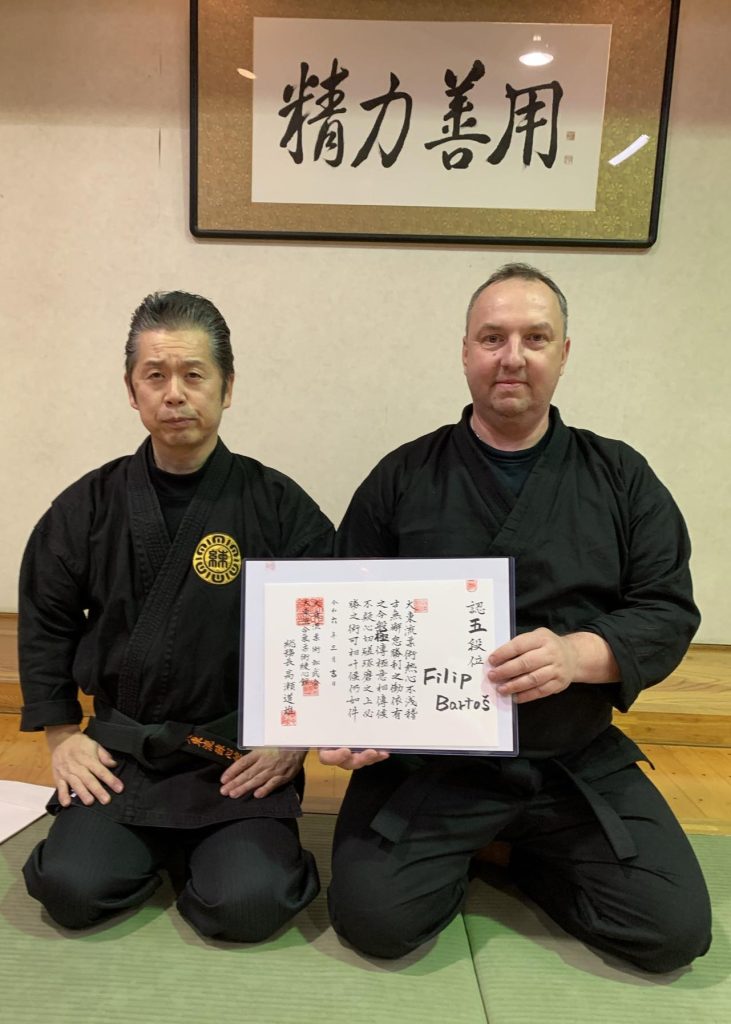Daito Ryu Jujutsu a Aikijujutsu Daitōryū Aiki-jūjutsu (大東流合氣柔術 ve zkratce: Daitōryū)
je 1200 let staré samurajské bojové umění, je považováno za jednu z nejstarších a nejušlechtilejších škol bojových umění v Japonsku a je národní kulturní hodnotou. Daitōryū je tradiční japonské bojové umění, které v roce 1087 založil Shinra Saburō Minamoto no Yoshimitsu (新羅 三郎 源 義光, (1056-1127), samuraj klanu Minamoto, třetí syn Minamoricen z páté generace Minamotoshi japonského císaře, dynastie Minamoto, Fujiwara Seiwa, bojový systém, pojmenovaný podle sídla Yoshi-mitsua, se později stal známým jako Daitōryū Toto umění bylo zdánlivě trénováno po několik staletí v rámci rodu Takeda z linie Minamoto Na konci 19. století Daitōryū poprvé veřejně vyučoval Takeda Sōkaku. Daitōryū Aiki-jūjutsu 大 東 (Daito = bydliště) 流 (ryu = škola) 合 (Ai = harmonie) 氣 (ki = dech, energie), 柔 術 (Jujutsu = jemné umění) je forma Jujutsu. Zahrnuje techniky boje zblízka jako: Atemi-Waza (techniky úderů a kopů), Shime-Waza (techniky škrcení), Kansetsu-Waza (techniky zamykání kloubů), Osae-Waza (techniky uchopování), Nage-Waza (techniky házení ), Aikinojutsu (hození soupeře na podlahu pomocí Aiki), Kyusho-waza (tlak na vitální body lidského těla). Praktik studuje použití některých starověkých zbraní Bushi (jako je Katana, Bo atd.). Mnoho technik Aikijujutsu je převedeno a katalogizováno ve svitcích (densho), které jsou v tomto případě Hiden Mokuroku rozděleny do sérií (kajo) se zvyšující se obtížností provedení. Daitō ryū Aiki-jūjutsu je tradiční japonské bojové umění, které bylo vyvinuto jako prostředek sebeobrany proti nevyprovokovanému násilí, s konečným cílem násilí spíše eliminovat než ho způsobit. To je jeden z důvodů, proč Daitō ryū spoléhá na formy (kata) a jejich praxi, ale nezahrnuje žádnou soutěž. Navíc, jako klasické japonské bojové umění, Daitō ryū znamená víc než jen čistou sebeobranu; Nabízí způsob, jak zkrotit své tělo a mysl se záměrem rozvíjet svůj osobní charakter a přispět k širší společenské prosperitě.
Takeda Sokaku měl mnoho studentů; Mezi nimi byl Toshimi (Hosaku) Matsuda, který získal licenci Daito-Ryu kyoju dairi kolem roku 1928. Byl to Matsuda, který byl prvním a hlavním učitelem Daito-Ryu Yoshiji Okuyamy (1901-1987). Na základě výzkumu studoval Okuyama s Matsudou senseiem od roku 1929 do roku 1939. Od tohoto data, jak bylo zaznamenáno v Takeda senseiově Eimeiroku (kniha), Okuyama sensei studoval přímo u Takedy Sokaku, Soshi na 13denním semináři v listopadu 1939. důležité, protože Okuyama se po této době nevrátil k Matuda senseiovi. Okuyama sensei začal učit Daito-ryu odděleně ve svém novém dojo, ale přestávka od Matsudova Renshinkanu se setkala s mnoha problémy. V letech 1940-1941 začal Okuyama sensei spolu se svým kohai a přítelem Maedou Takeshi senseiem (budoucím nástupcem Daito-Ryu Renshinkan) v letech 1941/42 vyučovat nového Ryuhu jménem Hakko-Ryu Jujutsu. Takese Michio sensei, současný soshi Daito Ryu Renshinkan uvedl, že původní svitky Hakko-ryu obsahovaly 220 waza, které zahrnovaly tradiční Daito-Ryu Hiden Mokuroku, Aiki no jutsu a Hiden Ogi. Byli to většinou Daito-ryu Renshinkan makimono přejmenované na Hakko-ryu. V následujících letech byl systém reorganizován na současný systém, který vidíme dnes.
Matsuda Den Daito Ryu Aikijujutsu Renshinkan
松田敏美伝大東流合気柔術「練心館」
Matsuda-den je škola mistra Toshimi ‚Hosaku‘ Matsuda 松田敏美. Matsuda Sensei byl velmi zkušeným studentem Sokaku Takedy, jeho dojo navštěvovalo mnoho zástupců jiných škol Daito-ryu. Ačkoli Matsuda Sensei neměl mnoho studentů, jeho škola Shobukan 松武會 dala vzniknout mnoha moderním bojovým uměním. Nejznámější bylo Hakko-ryu jujutsu. Mezi jeho studenty byli Korejci, což nebylo typické pro tradiční japonské školy bojových umění té doby. Jeden z jeho korejských studentů, Chang In Mok, měl určitý vliv na techniku Hapkido. Toshimi Matsuda napsal jednu z prvních příruček Daito-ryu, Iroha Kun, která popisovala základní principy jeho školy. Technicky se škola Matsuda skládá z více než 200 technik jujutsu, z nichž většina souvisí s Daito-ryu. Zbytek pochází z jiných škol jujutsu, které studoval Matsuda Sensei. Matsuda Sensei měl syna, ale nepokračoval v práci svého otce. Škola je oficiálně předána od Maeda Senseie zakladatele Renshinkan. Dnes od Kancho Michio Takase.
